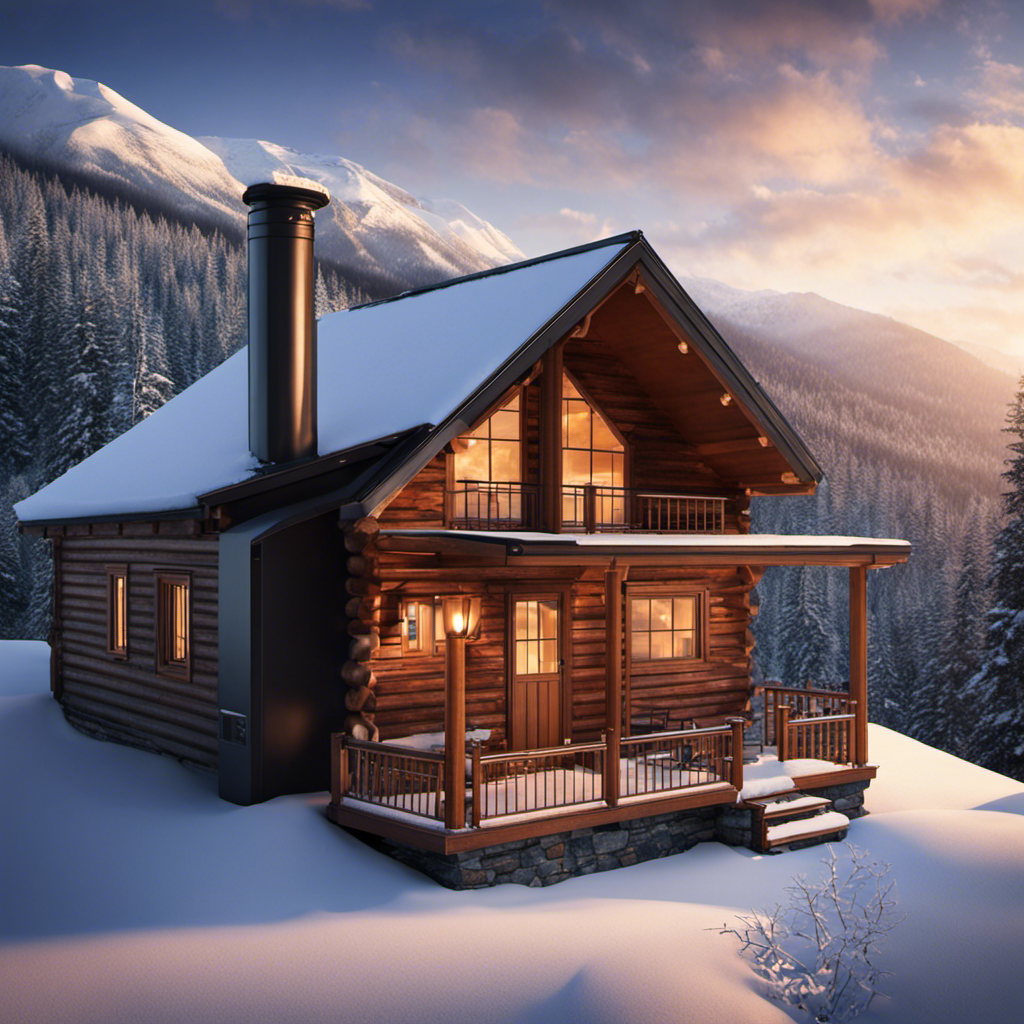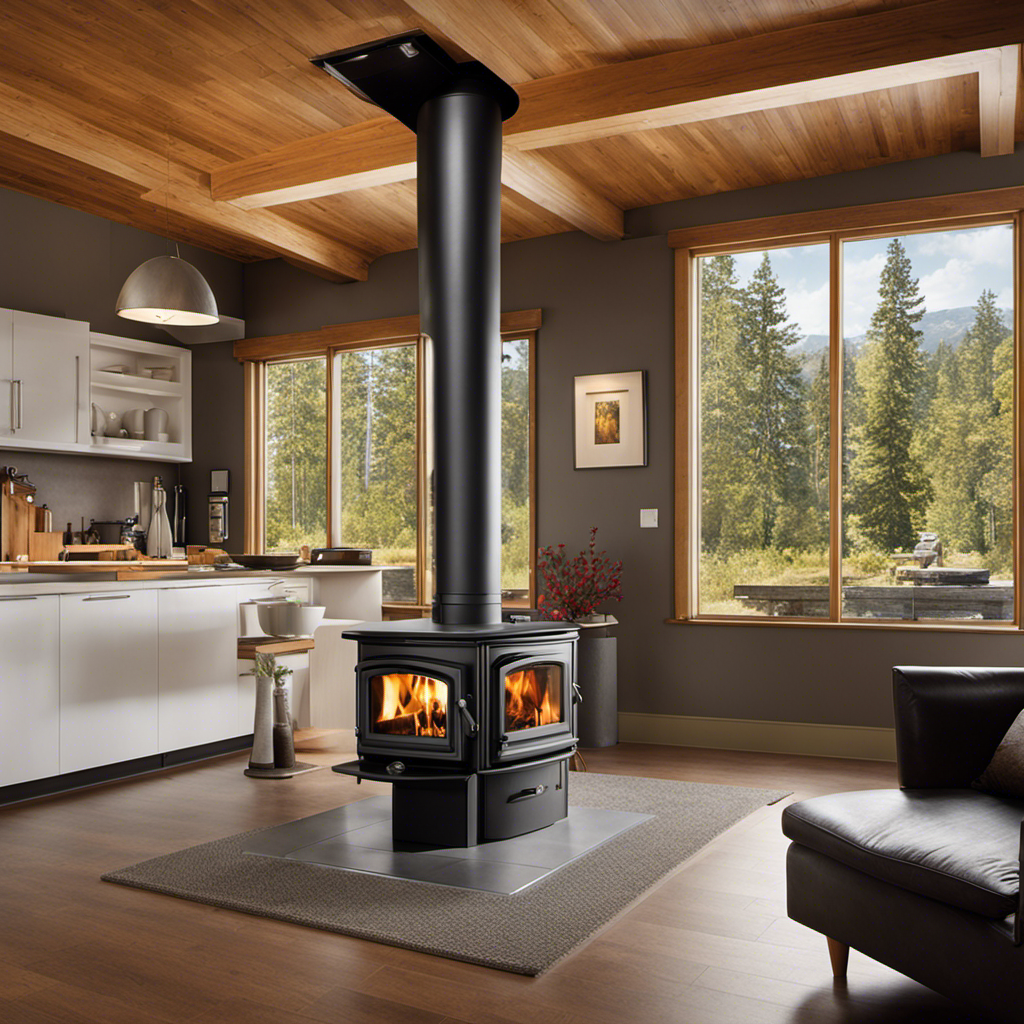Wood Stove
How Hot Does A Wood Stove Burn

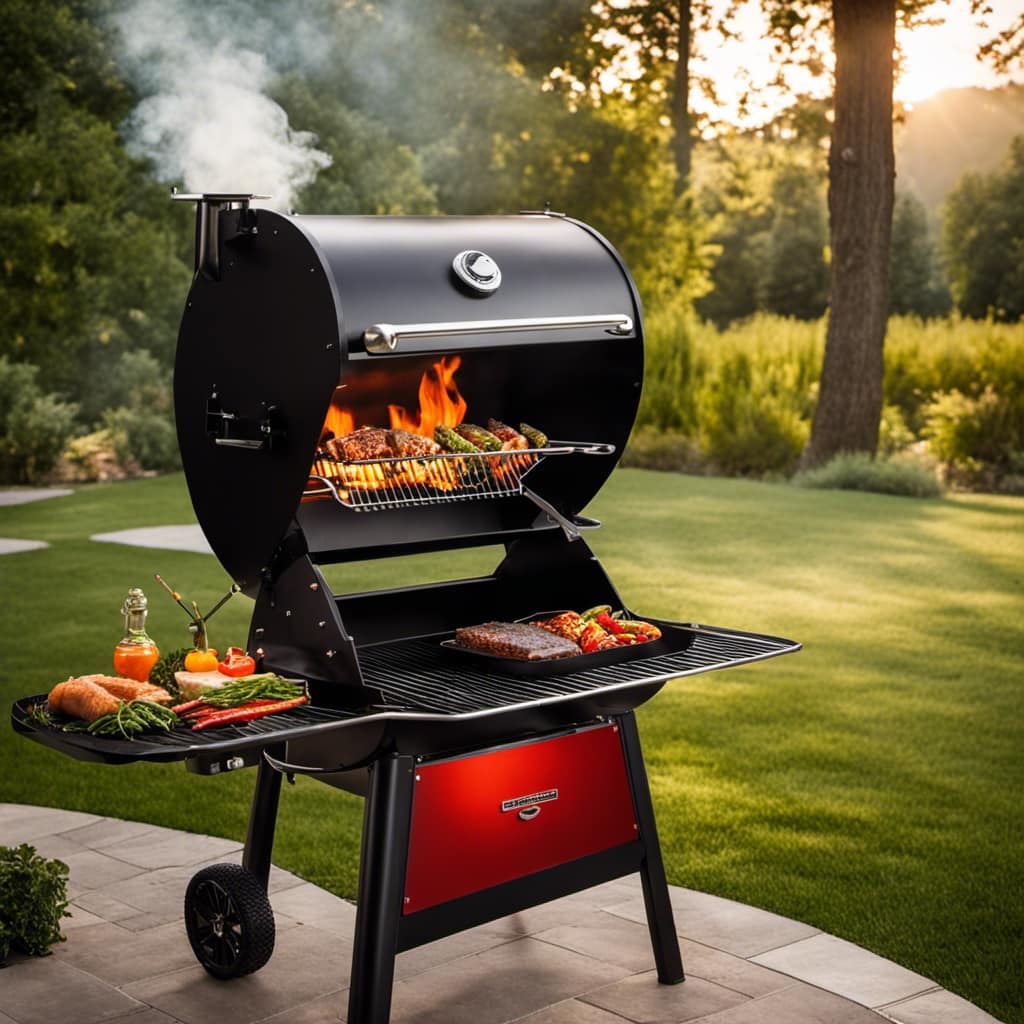
As a person with a deep appreciation for wood stoves, I often find myself marveling at the significant heat production of these humble appliances. It’s fascinating to consider the intense heat these compact devices can reach and the impact they have on our homes.
In this article, we will dive into the topic of how hot a wood stove can burn, exploring the factors that affect its temperature and the importance of controlling it for safety.
So, let’s stoke the fire and discover the secrets of wood stove heat!
Key Takeaways
- The type of wood used in a wood stove affects its temperature, with hardwoods like oak and maple burning hotter and longer than softwoods like pine or fir.
- The moisture content of the wood also plays a role in the stove’s temperature, with wet or green wood requiring more energy to burn and resulting in lower temperatures.
- Proper airflow is important for a clean and efficient burn, so the size and arrangement of the wood in the stove can impact its temperature.
- It is important to regulate the temperature of a wood stove to avoid dangers such as fire hazards, structural damage, burns and injuries, and carbon monoxide poisoning. Regular maintenance and control of air intake are crucial for safe operation.
Factors Affecting Wood Stove Temperature
I can feel the temperature of my wood stove fluctuate based on various factors.
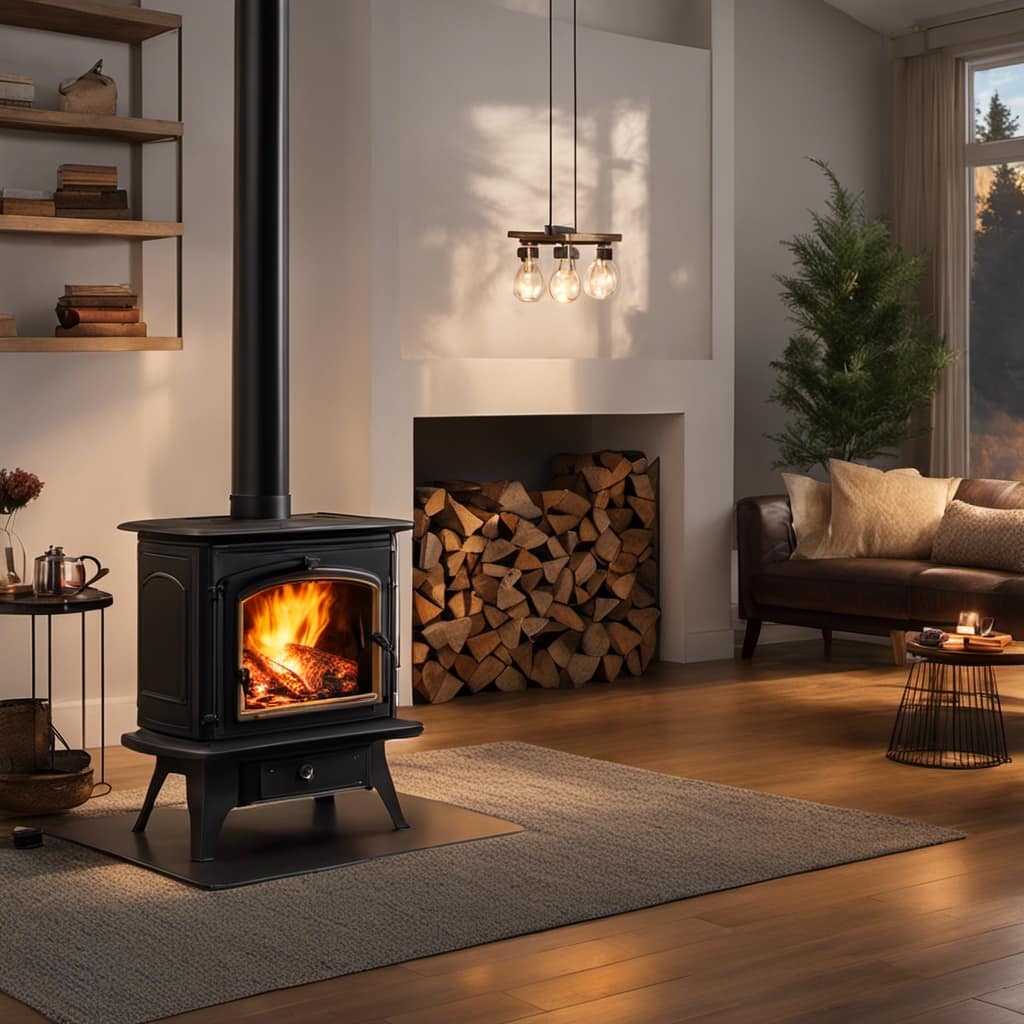
There are several key factors that influence the burn efficiency and temperature of a wood stove.
The first factor is the type of wood being burned. Hardwoods like oak and maple burn hotter and longer compared to softwoods like pine or fir.
The moisture content of the wood is also crucial. Wet or green wood takes more energy to burn, resulting in lower temperatures.
Another important factor is the air supply. Sufficient oxygen is necessary for a clean and efficient burn. If the stove isn’t receiving enough air, the temperature may drop.
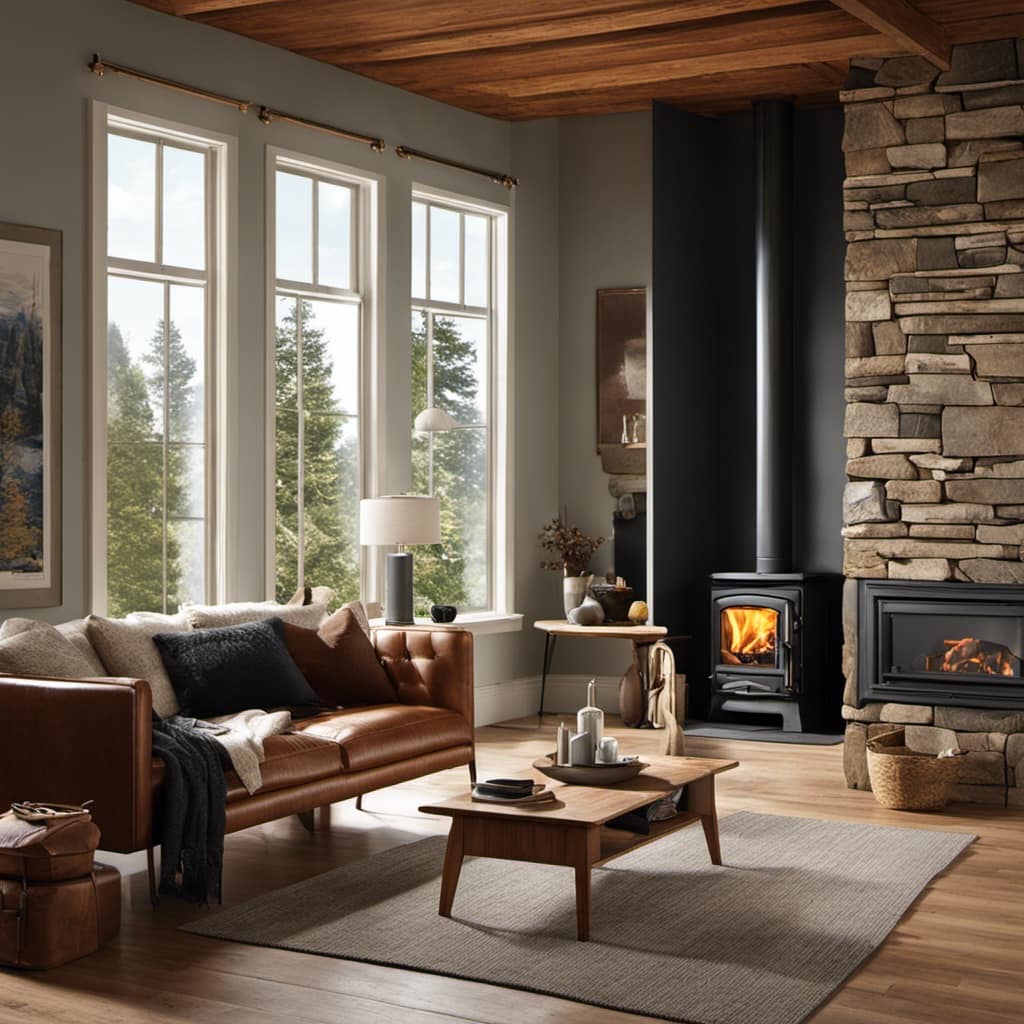
Lastly, the size and arrangement of the wood can impact the burn efficiency. Small, dry pieces of wood arranged in a stacked manner promote better air circulation and higher temperatures.
Understanding these factors is vital for maintaining a consistent and optimal burn temperature in a wood stove.
Understanding Wood Stove Heat Output
The heat output of a wood stove can vary depending on the type of wood used and how it’s properly maintained. To maximize the heat output and improve wood stove efficiency, here are some tips:
- Use seasoned hardwood: Hardwoods like oak, maple, and birch burn slower and produce more heat compared to softwoods.
- Properly stack the wood: Arrange the wood in a way that allows for proper airflow, ensuring efficient combustion.
- Keep the firebox clean: Regularly remove ashes and debris to maintain good airflow and prevent blockage.
- Control the air intake: Adjust the damper and air vents to regulate the amount of oxygen supplied to the fire, optimizing combustion.
- Use a heat reflector: Placing a heat reflector behind the wood stove can help radiate more heat into the room.
The Dangers of Excessive Wood Stove Heat
Excessive heat from a wood stove can pose serious risks, such as overheating the surrounding area and causing a potential fire hazard. It’s important to understand the dangers of overheating and the consequences of high temperatures.

When a wood stove burns too hot, it can lead to the combustion of nearby flammable materials, such as curtains or furniture, resulting in a dangerous fire. Additionally, the intense heat can cause structural damage to the walls and floors, compromising the integrity of the building.
High temperatures can also lead to burns and injuries if someone accidentally touches the hot surfaces. Moreover, overheating can increase the risk of carbon monoxide poisoning if the stove isn’t properly ventilated.
It’s crucial to regulate the temperature and ensure proper stove maintenance to avoid these dangerous situations.
Tips for Controlling Wood Stove Temperature
To maintain a safe and comfortable temperature, it’s important to regularly adjust the controls on my wood stove. Here are some tips for maintaining wood stove efficiency and troubleshooting temperature fluctuations:
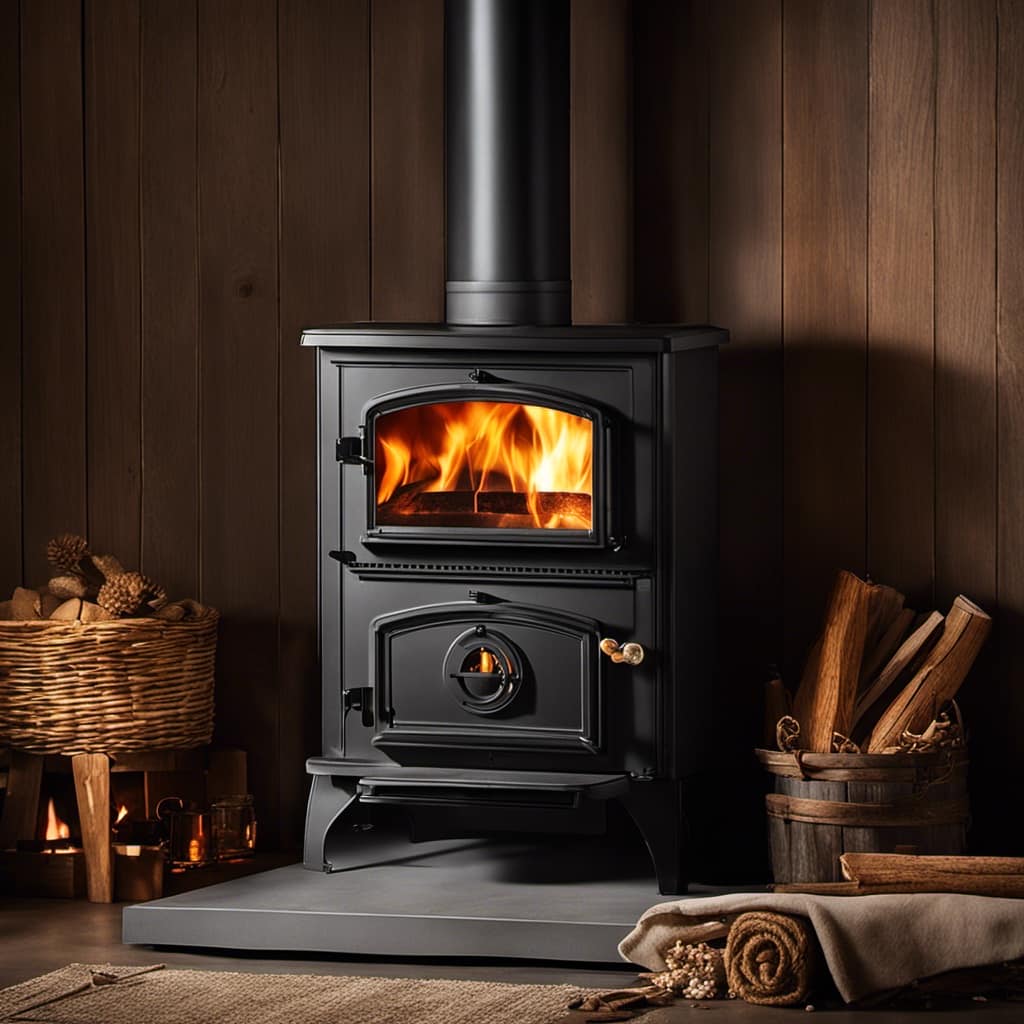
-
Clean the stove regularly to remove any buildup of ashes or debris that could hinder airflow.
-
Use seasoned firewood that has been properly dried for at least six months to ensure efficient and consistent burning.
-
Adjust the air vents to control the amount of oxygen entering the stove. Opening the vents fully will increase the heat output, while closing them partially will reduce it.
-
Install a stove thermometer to accurately monitor the temperature and make adjustments accordingly.
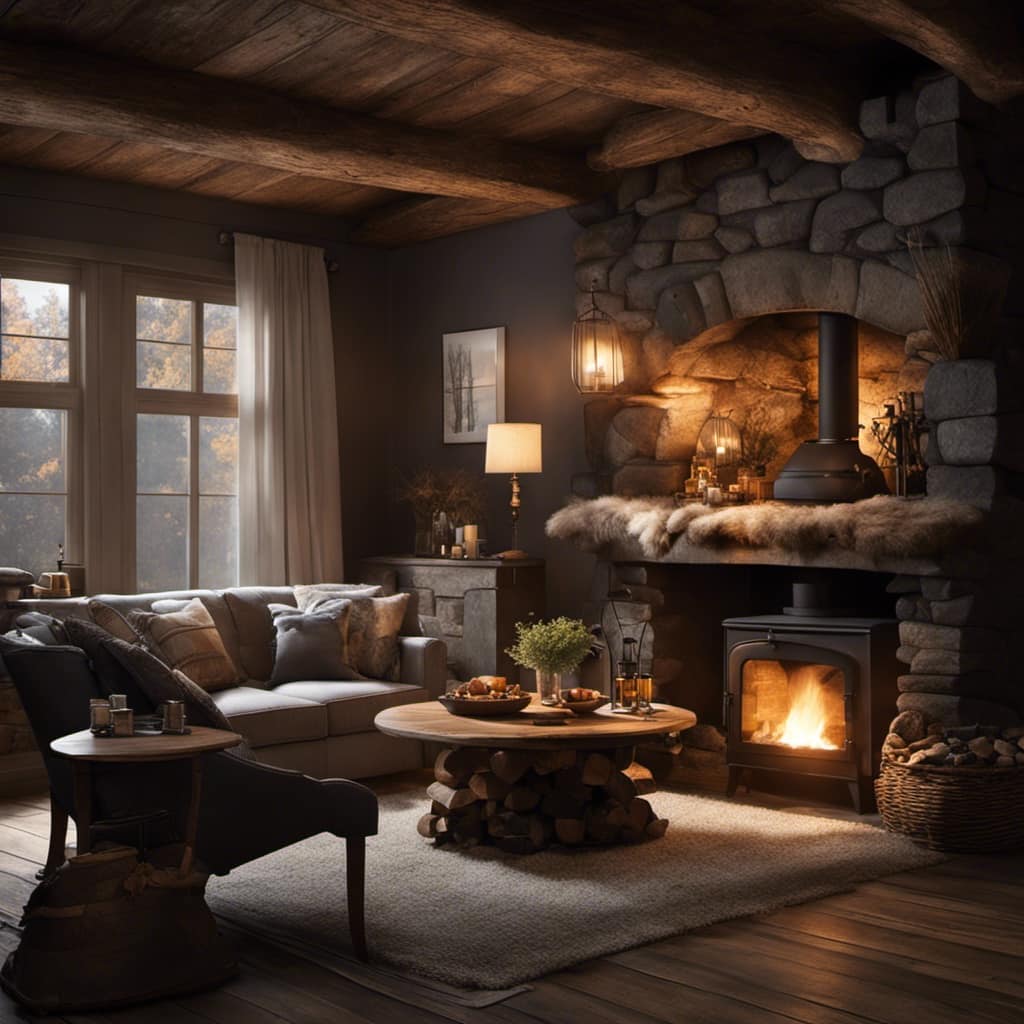
-
Consider using a heat-powered stove fan to distribute the warm air more efficiently throughout the room.
Exploring Safe Operating Temperatures for Wood Stoves
I need to ensure that my wood stove operates within a safe temperature range to prevent any potential hazards. Proper ventilation is crucial in maintaining a safe operating temperature for a wood stove. Without proper ventilation, the stove can overheat and pose a fire risk. It is important to have a clear understanding of the recommended temperature range for your specific wood stove model. Wood quality also plays a significant role in stove temperature. Wet or unseasoned wood burns less efficiently, leading to lower temperatures and increased smoke production. On the other hand, dry and well-seasoned wood burns hotter and cleaner. To better understand the impact of wood quality on stove temperature, take a look at the table below:
| Wood Type | Heat Output (BTU) | Temperature (°F) |
|---|---|---|
| Freshly cut | 5,000 – 6,000 | 300 – 400 |
| Seasoned | 7,000 – 8,000 | 400 – 600 |
| Kiln-dried | 9,000 – 10,000 | 600 – 800 |
| Hardwood | 12,000 – 15,000 | 800 – 1,000 |
Frequently Asked Questions
How Long Does It Take for a Wood Stove to Reach Its Maximum Temperature?
It typically takes a wood stove around 30-60 minutes to reach its maximum temperature. The time can vary based on factors such as the size of the stove, the type of wood, and the airflow.
Can Wood Stove Temperature Be Adjusted Easily?
Adjusting the wood stove temperature is relatively easy. By controlling the airflow and adjusting the damper, you can increase or decrease the heat output. This allows for precise control of the stove’s temperature.

What Are the Signs of a Wood Stove Overheating?
When a wood stove overheats, it can emit a strong, smoky smell, have discolored or warped metal parts, or produce excessive heat that’s difficult to control. These signs indicate potential dangers and should be addressed immediately.
Are There Any Specific Types of Wood That Burn Hotter in a Wood Stove?
When selecting wood for a wood stove, it’s crucial to choose specific types that burn hotter. This ensures maximum heat output. Factors like density, moisture content, and wood species determine the heat generated.
Can Wood Stoves Be Used as the Primary Source of Heating in Larger Homes?
Wood stoves can be used as the primary heating source in larger homes, but it’s important to consider the size and layout. They are efficient and can provide warmth, but other heating options may be more suitable.
Conclusion
In conclusion, a wood stove can burn incredibly hot, reaching temperatures that can keep you warm even on the coldest of winter nights.

However, it’s important to be cautious and control the temperature to avoid any potential dangers.
By understanding the factors that affect wood stove temperature and following some simple tips, you can safely enjoy the cozy warmth that a wood stove provides.
Just remember to keep the fire within the bounds of a controlled inferno, creating a comforting ambiance in your home.
Growing up surrounded by the vast beauty of nature, Sierra was always drawn to the call of the wild. While others sought the comfort of the familiar, she ventured out, embracing the unpredictable and finding stories in the heartbeat of nature.
At the epicenter of every remarkable venture lies a dynamic team—a fusion of diverse talents, visions, and passions. The essence of Best Small Wood Stoves is crafted and refined by such a trio: Sierra, Logan, and Terra. Their collective expertise has transformed the platform into a leading authority on small wood stoves, radiating warmth and knowledge in equal measure.
Wood Stove
How To Humidify With An Insert Wood Stove

As a person owning a home, I’ve consistently sought methods to make my living space cozy and heated through the colder season. An approach that has proven to be remarkably useful is employing a wood stove insert to add moisture to the air.
Not only does it provide warmth, but it also adds moisture to the air, preventing dryness and improving overall indoor air quality.
In this article, I’ll share my knowledge and experience on choosing the right wood, setting up the stove, and maintaining optimal moisture levels for effective humidification.
Key Takeaways
- Increasing indoor humidity with an insert wood stove can alleviate dry skin, chapped lips, and respiratory issues.
- Using the right type of wood, such as oak, maple, or birch, can affect moisture content, burning rate, and heat output.
- Positioning the insert wood stove near a water source and above a heat-resistant surface helps draw in moisture and release it as steam into the air.
- Monitoring humidity levels, using a hygrometer, strategically placing bowls of water near the stove, and considering additional humidification methods can help maintain proper moisture levels in the home.
Benefits of Humidifying With an Insert Wood Stove
I’m really enjoying the benefits of humidifying with my insert wood stove. One of the main advantages is the significant increase in indoor humidity. As the stove burns, it releases moisture into the air, creating a more comfortable and healthier environment.
This is particularly beneficial during the winter months when the air tends to be dry. By increasing indoor humidity, my insert wood stove helps to alleviate dry skin, chapped lips, and respiratory issues such as dry coughs and sore throats. It also helps to keep the sinuses moist, reducing the likelihood of sinusitis and nasal congestion.
Additionally, the increased humidity can help to prevent wood furniture and flooring from drying out and cracking. Overall, the health benefits of humidifying with an insert wood stove are impressive, making it a valuable addition to any home.
Choosing the Right Wood for Humidification
Choosing the right wood for humidification can greatly impact the effectiveness of my insert wood stove in increasing indoor humidity. Proper wood selection is essential for efficient moisture regulation and optimal performance. Different types of wood have varying moisture content, burning rates, and heat output, all of which affect the humidification process. To help you make an informed decision, I have provided a table below that outlines the characteristics of commonly used woods for humidifying with an insert wood stove.
| Wood Type | Moisture Content | Burning Rate | Heat Output |
|---|---|---|---|
| Oak | Low | Slow | High |
| Maple | Medium | Moderate | Medium |
| Birch | High | Fast | Low |
Setting Up Your Insert Wood Stove for Maximum Humidification
To achieve maximum humidification with my insert wood stove, I need to carefully position it near a water source and above a heat-resistant surface. This setup allows for efficient water evaporation without causing any moisture damage to the surrounding area.
Maximizing efficiency is crucial in ensuring that the stove effectively adds moisture to the air, creating a comfortable and healthy indoor environment. By placing the wood stove near a water source, such as a humidifier or a water-filled container, the stove can draw in moisture and release it as steam into the air.
Additionally, positioning the stove above a heat-resistant surface, such as a heat-resistant mat or a tiled area, prevents any potential damage caused by heat or water spillage.
Taking these precautions ensures optimal humidification without compromising safety or causing moisture-related issues.
Maintaining Proper Moisture Levels in Your Home
I regularly monitor the humidity levels in my home to ensure that they stay within a healthy range. Maintaining proper moisture levels is crucial for the overall indoor air quality.
Low humidity can lead to a variety of common issues that can affect both my health and the condition of my home. One of the most important aspects of indoor air quality is maintaining the right humidity level. Dry air can cause several problems, such as dry skin, irritated eyes, and respiratory issues. It can also lead to the development of static electricity, which can damage electronic devices and cause discomfort.
Low humidity levels can also have negative effects on the structure of my home. It can cause wood furniture and floors to shrink and crack, paint to peel, and wallpaper to peel off. Additionally, low humidity can impact indoor plants, causing them to wilt and die.
To combat these issues, I use a humidifier to increase the moisture levels in my home. This helps to maintain a healthier indoor environment and prevent the common problems associated with low humidity levels.
Tips and Tricks for Effective Humidification With an Insert Wood Stove
Using a hygrometer and strategically placing bowls of water near the insert wood stove can help to increase humidity levels effectively. Increasing humidity is crucial in preventing dryness, especially during the winter months when the air tends to be drier. The hygrometer allows you to monitor the humidity levels in your home accurately.
By placing bowls of water near the insert wood stove, the heat will cause the water to evaporate, increasing the moisture in the air. It’s essential to place the bowls strategically, ensuring they aren’t too close to the stove to avoid accidents.
Additionally, consider using a humidifier or a kettle on the stove to further contribute to increasing humidity levels. Remember to regularly check the hygrometer and refill the bowls to maintain optimal humidity levels.
Frequently Asked Questions
What Is the Average Cost of Installing an Insert Wood Stove for Humidification?
The average cost of installing an insert wood stove for humidification varies depending on factors such as the type of stove and installation requirements. However, the benefits of using an insert wood stove for humidification include improved air quality and increased moisture levels in your home.
Can I Use Any Type of Wood in an Insert Wood Stove for Humidification?
Yes, you can use different types of wood in an insert wood stove for humidification. The benefits of using an insert wood stove include efficient heating and the ability to control the moisture levels in your home.
How Long Does It Take for the Humidity Levels to Increase After Using an Insert Wood Stove?
It usually takes a couple of hours for the humidity levels to increase after using an insert wood stove. However, the average time can vary depending on factors such as room size and ventilation. Following best practices ensures optimal results.
Are There Any Health Risks Associated With Humidifying With an Insert Wood Stove?
There are potential health risks associated with using an insert wood stove to humidify. It is important to ensure proper ventilation and maintenance to prevent carbon monoxide buildup and other hazards.
Can I Use an Insert Wood Stove for Humidification in a Small Apartment or Only in Larger Homes?
Using an insert wood stove for humidification in small apartments offers numerous benefits. It can effectively increase humidity levels, improve air quality, and provide warmth. To maximize efficiency, ensure proper ventilation and monitor humidity levels regularly.
Conclusion
In conclusion, humidifying with an insert wood stove offers numerous benefits. It improves indoor air quality and prevents dryness. While some may argue that it requires constant maintenance, the comfort and health benefits it provides far outweigh the effort.
By following the proper steps and using the right wood, you can effectively humidify your home and create a cozy and comfortable environment. Don’t let the fear of maintenance deter you from enjoying the warmth and benefits of an insert wood stove.
Wood Stove
How Far Does A Wood Stove Need To Be Away From A Brick Wall
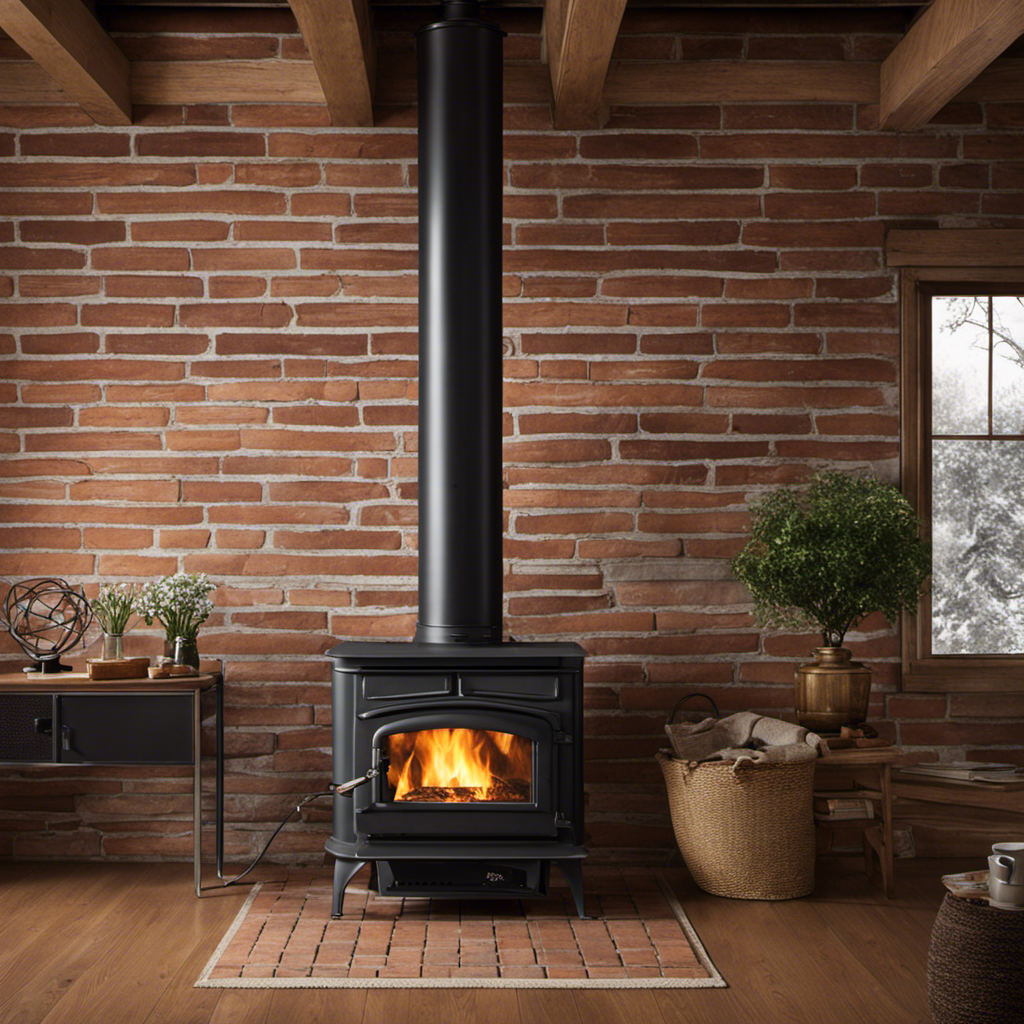
I often think about the necessary distance between my wood stove and a brick wall to keep both safety and efficiency at optimal levels. Adhering to building regulations and recommendations for appropriate positioning is crucial.
Recommended clearance distances and factors like ventilation and heat distribution play a crucial role.
Maintaining a safe and efficient wood stove-to-brick wall clearance is essential. Let’s dive into the technical details and explore the guidelines for keeping our wood stoves a safe distance from brick walls.
Key Takeaways
- Building codes and regulations require permits for wood stove installation and ensure safety standards are met.
- Recommended clearance distances between wood stoves and brick walls prevent fire risks and are determined by factors such as stove type and room size.
- Proper ventilation and heat distribution around a wood stove near a brick wall can be achieved through the use of fans, ductwork, and following ventilation requirements.
- Regular maintenance, including measuring and adjusting clearance distance, cleaning the stove and inspecting the brick wall for heat damage, is important for safe and efficient operation.
Building Codes and Regulations for Wood Stove Placement
I’m not sure about the building codes and regulations for wood stove placement, but I think it’s important to consider them when installing a wood stove.
Building permits are typically required for installing a wood stove, as they ensure that the installation meets the necessary safety standards. Fire safety considerations are a crucial aspect of these regulations, as wood stoves can pose a fire hazard if not installed properly.
These regulations may specify the minimum clearance distances that need to be maintained between the wood stove and combustible materials, such as brick walls. This ensures that there’s enough space to prevent heat transfer and potential ignition of the surrounding materials.
Understanding and adhering to these regulations is vital to ensure the safe and proper installation of a wood stove.
Moving forward, let’s discuss the recommended clearance distances for wood stoves and brick walls.
Recommended Clearance Distances for Wood Stoves and Brick Walls
How close should a wood stove be to a brick wall to ensure safe clearance distances?
When it comes to wood stove installation, recommended safety precautions must be followed to avoid potential hazards. One common mistake to avoid is placing the stove too close to a brick wall, as this can pose a fire risk.
The distance between a wood stove and a brick wall should be determined by several factors to ensure adequate clearance. These factors include the type of stove, the size of the room, the flue pipe configuration, and the materials used in the construction of the wall.
Factors to Consider When Determining the Distance Between a Wood Stove and a Brick Wall
When determining the distance between a wood stove and a brick wall, it’s crucial to take into account various factors such as the stove’s heat output and the wall’s construction materials. These factors play a significant role in ensuring the safety and efficiency of the wood stove installation. Building codes provide guidelines for the minimum clearance distances required between a wood stove and any combustible material, including brick walls. These codes are designed to prevent fire hazards and ensure proper ventilation. The table below illustrates the recommended clearance distances based on the stove’s heat output and the wall’s construction material.
| Heat Output (BTU/hour) | Brick Wall Material | Minimum Clearance Distance (inches) |
|---|---|---|
| 0-40,000 | Non-combustible | 12 |
| 40,001-60,000 | Non-combustible | 18 |
| 60,001 and above | Non-combustible | 24 |
Ensuring Proper Ventilation and Heat Distribution Around a Wood Stove Near a Brick Wall
To ensure proper ventilation and heat distribution around a wood stove near a brick wall, it’s essential to maintain a sufficient distance and use a fan or other means of circulating air. Ventilation requirements play a crucial role in keeping the area around the wood stove safe and efficient. Here are three important considerations to keep in mind:
-
Clearances: Maintain the recommended distance between the wood stove and the brick wall to prevent heat transfer and potential fire hazards.
-
Airflow: Position a fan near the wood stove to promote air circulation and distribute heat evenly throughout the room. This will help prevent hotspots and ensure a comfortable environment.
-
Ductwork: Install ductwork to direct the heated air away from the wood stove and towards the desired areas of the room. This will enhance heat distribution and improve overall efficiency.
By following these ventilation requirements and implementing heat distribution strategies, you can create a safe and comfortable environment around your wood stove.
Now, let’s discuss some tips for maintaining a safe and efficient wood stove-to-brick wall clearance.
Tips for Maintaining a Safe and Efficient Wood Stove-To-Brick Wall Clearance
I have found that by regularly measuring and adjusting the wood stove-to-brick wall clearance, I can ensure a safe and efficient setup. Maintaining the proper distance between the wood stove and the brick wall is crucial for preventing damage and ensuring optimal performance.
To clean a wood stove effectively, start by allowing it to cool down completely. Remove the ashes and debris using a metal scoop or brush and dispose of them in a designated outdoor area. Wipe down the interior surfaces with a damp cloth to remove any built-up soot or creosote.
For the brick wall, it’s important to regularly inspect for any signs of heat damage, such as cracked or discolored bricks. If damage is detected, it’s recommended to consult a professional to assess and repair the brick wall.
Frequently Asked Questions
What Are the Potential Risks of Placing a Wood Stove Too Close to a Brick Wall?
Placing a wood stove too close to a brick wall can pose potential health hazards and fire hazards. The heat from the stove can transfer to the brick, increasing the risk of fire and causing damage to the wall.
Can I Use Any Type of Brick Wall as a Heat Shield for My Wood Stove?
Using any type of brick wall as a heat shield for a wood stove is not recommended. Brick walls are not designed for heat resistance and there are alternative heat shield materials available for better safety.
Are There Any Specific Building Materials or Products That Can Be Used to Increase the Safety of a Wood Stove Near a Brick Wall?
Building material options and safety precautions can help increase the safety of a wood stove near a brick wall. It is important to consider the distance required and use appropriate materials to prevent fire hazards.
How Can I Ensure Proper Ventilation Around a Wood Stove Near a Brick Wall?
Proper ventilation around a wood stove near a brick wall is crucial. Regular maintenance is important to ensure safety. Insulation should be installed to prevent heat transfer and protect the wall.
Is It Necessary to Have a Professional Install a Wood Stove in Order to Ensure Proper Clearance From a Brick Wall?
I didn’t need a professional to install my wood stove near a brick wall. I made sure to follow the guidelines for proper clearance to ensure safety. It’s crucial to prioritize wood stove installation and safety.
Conclusion
In conclusion, it’s crucial to adhere to building codes and regulations when determining the distance between a wood stove and a brick wall. The recommended clearance distance is typically 36 inches, but it may vary depending on factors such as the type of stove and the wall material.
Interestingly, proper ventilation and heat distribution play a significant role in maintaining a safe and efficient wood stove-to-brick wall clearance. Taking these factors into consideration ensures a comfortable and secure heating experience.
Logan’s affair with adventure began in childhood. He hailed from a small town where vast forests bordered one side and endless shores stretched on the other. His days were spent exploring uncharted woods, climbing tall trees, or listening to the tales of old sailors. This early immersion in a world brimming with stories and mysteries became the foundation of his passion for writing.
Wood Stove
What Does A Blower Do On A Wood Stove
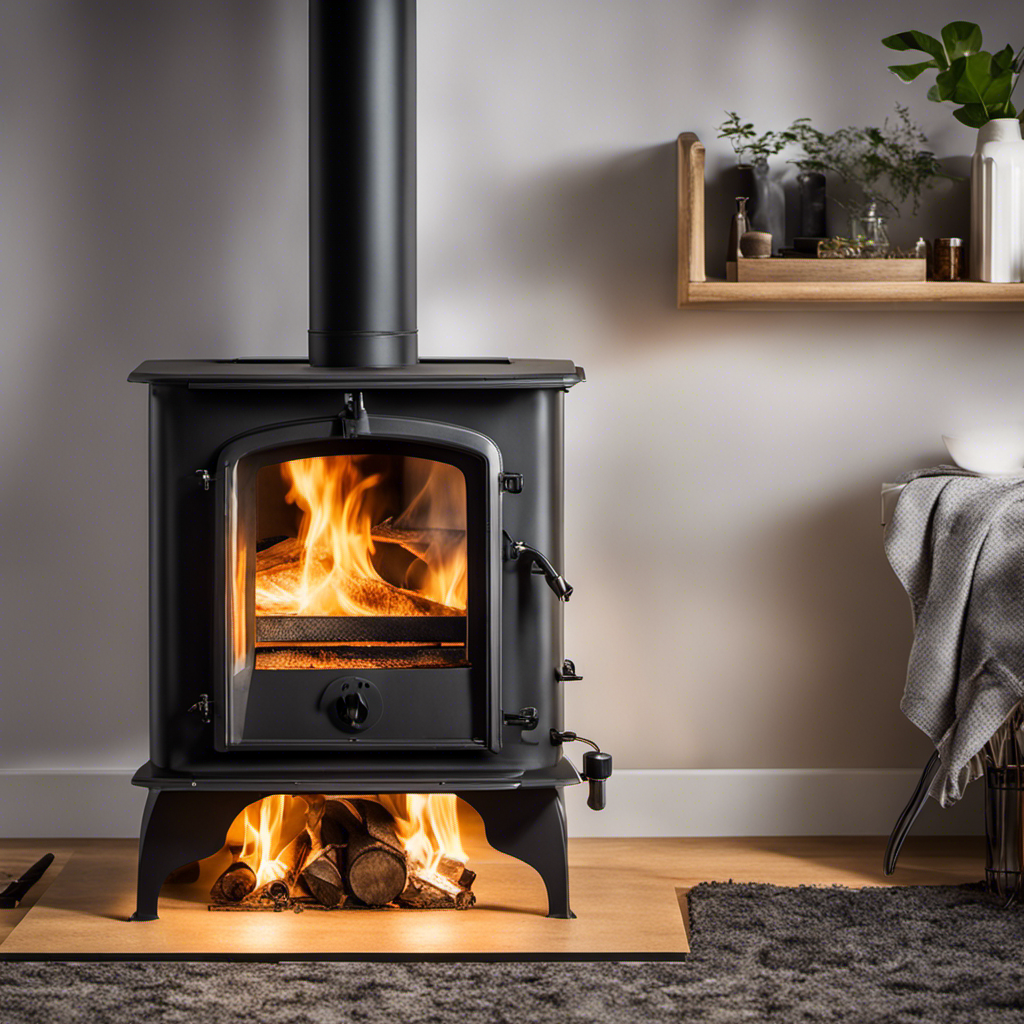
As someone who deeply appreciates wood stoves, I’ve always been intrigued by the complex parts that allow these heating devices to function efficiently.
One key element that often goes unnoticed is the blower. This small yet mighty device plays a crucial role in enhancing the efficiency of your wood stove.
By circulating air and distributing heat more evenly, the blower ensures that every corner of your space stays warm and toasty.
In this article, I’ll delve into the mechanics of a wood stove blower and explore the many benefits it brings to your home.
Key Takeaways
- A blower on a wood stove circulates air and distributes heat more evenly, enhancing the stove’s efficiency.
- The placement of the blower affects heat distribution, with different positions drawing in the hottest air, capturing maximum heat, or preventing cold spots.
- Having a blower on a wood stove improves the warmth and comfort of a home, reduces heating costs, promotes better combustion, and contributes to environmental sustainability.
- The mechanics of a blower involve a motor, fan, and housing that draw in cool air, absorb heat from the stove surfaces, and force warm air out through vents, circulating in the room.
The Functionality of a Blower
I’m really impressed with the functionality of a blower on a wood stove – it helps circulate the warm air more efficiently.
When it comes to the installation process of a blower on a wood stove, there are a few key steps to follow.
First, you need to ensure that the blower is compatible with your specific wood stove model.
Then, you’ll need to remove the back panel of the stove to access the blower compartment.
Next, you’ll connect the blower to the power source and secure it in place with screws.
Finally, you can replace the back panel and test the blower to ensure it’s working properly.
There are different types of blowers available for wood stoves, including freestanding blowers and built-in blowers.
These options allow you to choose the best blower for your specific needs.
With a blower installed, the warm air is circulated more efficiently throughout the room, enhancing the overall efficiency of the wood stove.
How a Blower Enhances Efficiency
Using a blower on a wood stove significantly improves its efficiency by circulating warm air more effectively. The placement of the blower is crucial in ensuring optimal heat distribution. Here are three key factors to consider:
-
Blower Placement:
-
Placing the blower near the top of the wood stove allows it to draw in the hottest air and distribute it throughout the room.
-
Positioning the blower near the back of the stove ensures that it captures the maximum amount of heat before it escapes through the chimney.
-
Installing a blower on the side of the stove helps to evenly distribute the warm air, preventing cold spots and improving overall comfort.
-
Blower Speed:
-
Adjusting the blower speed allows for fine-tuning the heat distribution. A higher speed setting can quickly warm up a room, while a lower speed setting provides a more gradual and consistent heat output.
-
It’s important to find the right balance, as a blower set too high may cause excessive noise and unnecessary energy consumption.
-
Airflow Direction:
-
The direction of airflow can be adjusted to target specific areas in the room that require more heat. This feature allows for customizable comfort and efficient heat distribution.
The Benefits of Having a Blower on Your Wood Stove
Having a blower on my wood stove has greatly improved the warmth and comfort of my home. The advantages of having a blower are numerous, with the most significant being energy saving.
A blower helps to distribute the heat generated by the wood stove more efficiently throughout the room or even the entire house. By circulating the warm air, the blower ensures that every corner of the space is evenly heated. This means that I can set my thermostat lower, saving energy and reducing my heating costs.
Additionally, the blower increases the overall efficiency of the wood stove by promoting better combustion and reducing the amount of smoke and emissions released into the environment.
Overall, having a blower on my wood stove hasn’t only enhanced the warmth and comfort of my home but also contributed to energy savings and environmental sustainability.
Understanding the Mechanics of a Blower
I can better appreciate the benefits of a blower by understanding the mechanics behind its operation and by observing how it effectively distributes the warm air throughout my home. A blower serves the purpose of increasing the efficiency of a wood stove by circulating the heated air.
Here is how a blower works:
- The blower is typically located at the back or side of the wood stove.
- It consists of a motor, fan, and housing.
- When the wood stove reaches a certain temperature, the blower is activated.
- The motor powers the fan, which draws in cool air from the room.
- The fan then pushes the cool air across the heated surfaces of the wood stove, absorbing the heat.
- The now warm air is then forced out through the vents in the blower housing, circulating it throughout the room.
Understanding the mechanics of a blower allows me to fully appreciate its role in efficiently distributing the warmth generated by my wood stove.
Tips for Properly Maintaining Your Wood Stove Blower
To ensure optimal performance, it’s important to regularly clean and lubricate your wood stove blower. Wood stove blower maintenance is crucial for efficient operation and longevity of your heating system. Dust, debris, and dirt can accumulate on the blower blades, reducing its airflow and overall performance. By cleaning the blower regularly, you can prevent this buildup and ensure maximum airflow.
Additionally, lubricating the blower motor bearings and shaft will reduce friction and extend the lifespan of the motor. Troubleshooting common blower issues involves checking for loose or damaged belts, inspecting the electrical connections for any loose or corroded wires, and ensuring the blower motor is receiving the appropriate voltage.
Regular maintenance and troubleshooting can help resolve common blower issues and keep your wood stove operating smoothly.
Frequently Asked Questions
How Does a Blower Affect the Heat Distribution in a Room?
A blower on a wood stove improves heat distribution in a room by circulating warm air. It increases blower efficiency, allowing for faster and more even heating. This creates a comfortable environment and maximizes the stove’s heating capabilities.
Can a Blower Be Added to an Existing Wood Stove?
Adding a blower to an existing wood stove maximizes heat distribution, creating a cozy atmosphere. This upgrade improves the efficiency by pushing warm air into the room instead of relying solely on natural convection.
Will Using a Blower on a Wood Stove Increase the Lifespan of the Stove?
Using a blower on a wood stove can increase its lifespan by improving energy efficiency. However, it’s important to note that a blower can also impact air quality, so proper ventilation and maintenance are crucial.
What Is the Average Noise Level of a Wood Stove Blower?
The average noise level of a wood stove blower is around 50 decibels, which is comparable to a quiet conversation. However, it’s important to note that using a blower can increase energy consumption.
Are There Any Safety Concerns or Precautions to Keep in Mind When Using a Blower on a Wood Stove?
When using a blower on a wood stove, it is important to keep in mind safety concerns and take proper precautions. Regular blower maintenance is also necessary to ensure its efficient and safe operation.
Conclusion
In conclusion, a wood stove blower is an essential component that greatly enhances the efficiency of your wood stove. By circulating the warm air throughout the room, it ensures a more even and consistent heat distribution.
This not only maximizes the heating potential of your wood stove but also reduces the amount of fuel required.
So, if you want to make the most out of your wood stove and enjoy a cozy and warm environment, investing in a blower is a wise choice.
Don’t miss out on this game-changing accessory for your wood stove!
-

 Wood Stove4 weeks ago
Wood Stove4 weeks agoWhen To Open And Close Damper On Wood Stove
-

 Wood Stove3 weeks ago
Wood Stove3 weeks agoHow To Build A Thermoelectric Generator For A Wood Stove
-

 Wood Stove4 weeks ago
Wood Stove4 weeks agoHow To Use Damper And Draft On Wood Stove
-

 Wood Stove3 weeks ago
Wood Stove3 weeks agoHow Does A Circulator Wood Stove Work
-

 Pellet Stoves2 days ago
Pellet Stoves2 days agoWhy Is My Wood Pellet Stove Putting so Much Soot
-

 Wood Stove3 weeks ago
Wood Stove3 weeks agoHow Far Does Wood Stove Have To Be From Wall
-

 Wood Stove4 weeks ago
Wood Stove4 weeks agoWhat Can I Use As Insulation On Wood Stove Pipes
-

 Pellet Stoves4 days ago
Pellet Stoves4 days agoHow to Make a Pellet Basket for Wood Burning Stoves









